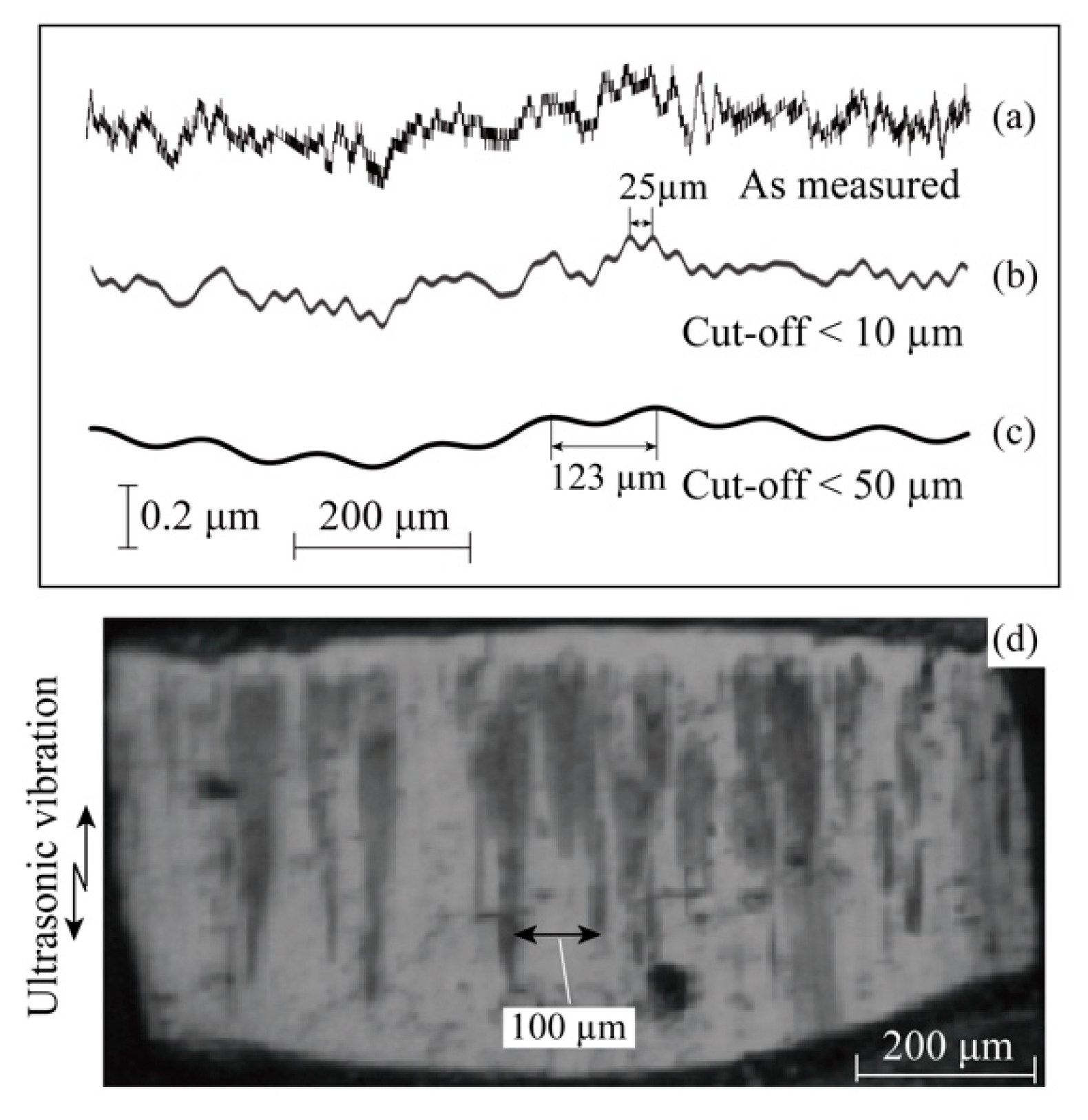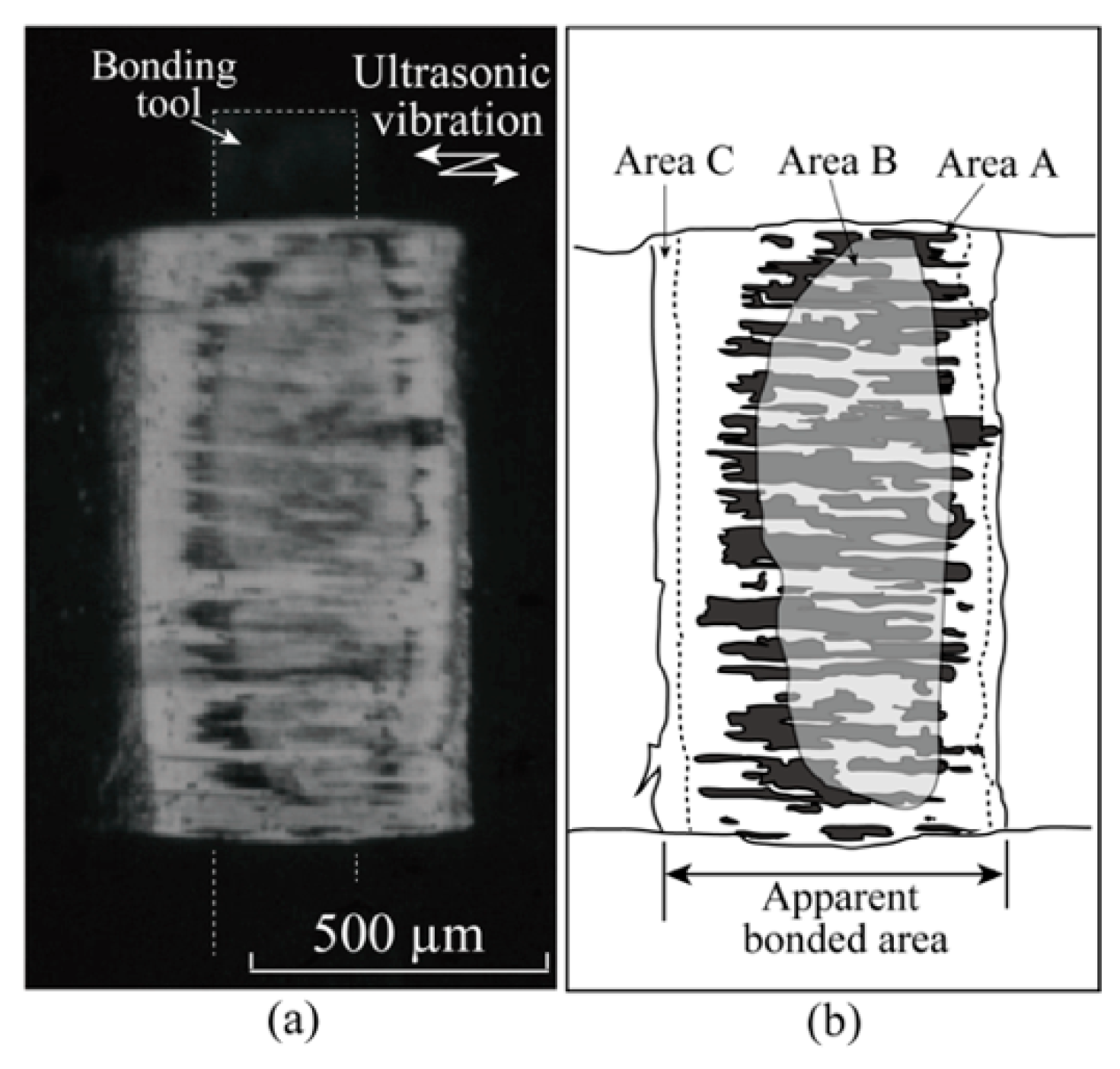In-Situ Observation of Adhesion Behavior During Ultrasonic Al Ribbon Bonding
Abstract
:1. Introduction
2. Experimental Procedures
3. Results
3.1. Behavior of Ultrasonic Vibration Amplitude
3.2. In-Situ Observation of Adhesion Behavior Obtained at a Frame Rate of 104 fps
3.3. In-Situ Observation of Adhesion Behavior Captured at a Frame Rate of 103 fps
3.4. In-Situ Observation of the Fracture Process in Twist and Peel Test
4. Discussion
5. Conclusions
- (1)
- Immediately after introducing the ultrasonic vibration, the ribbon was largely shaken, that is, a large friction slide occurred. Initial poor adhesion was locally produced. Macro-folding arose and the apparent contact width increased.
- (2)
- The island streaks were clearly observed at 104 fps. Conversely, the central belt zone looked translucent at 104 fps; although it was clear when observed at 103 fps. The island streaks were unclear at 103 fps.
- (3)
- The island streaks were formed as a footprint derived from the Al surface waviness. The island streaks grew long and parallel to the direction of ultrasonic vibration.
- (4)
- The central belt zone was formed, normal to the direction of ultrasonic vibration. The island streaks did not change into the central belt zone. The central belt zone was clearly captured at 103 fps.
- (5)
- The central belt zone remained on the silica side after fracture in the twist and peel test.
- (6)
- The central belt zone was between the island streaks and the silica substrate. The central belt zone must be formed by the interfacial reaction.
- (7)
- Microslipping and microfolding mechanisms can occur in the ultrasonic bonding.
Author Contributions
Funding
Conflicts of Interest
References
- Takahashi, Y.; Fukuda, H.; Yoneshima, Y.; Kitamura, H.; Maeda, M. Solid-state microjoining mechanisms of wire bonding and flip chip bonding. ASME J. Electron. Packag. 2017, 139, 041010-1–041010-13. [Google Scholar] [CrossRef]
- Higashi, Y.; Iwamoto, C.; Kawamura, Y. Microstructure evolution and mechanical properties of extruded Mg96Zn2Y2 alloy joints with ultrasonic spot welding. Mater. Sci. Eng. A 2016, 651, 925–934. [Google Scholar] [CrossRef]
- Sasaki, T.; Watanabe, T.; Hosokawa, Y.; Yanagisawa, A. Analysis for relative motion in ultrasonic welding of aluminium sheet. Sci. Technol. Weld. Join. 2013, 18, 19–24. [Google Scholar] [CrossRef]
- Li, H.; Cao, B.; Liu, J.; Yang, J. Modeling of high-power ultrasonic welding of Cu/Al joint. Inter. J. Adv. Manufac. Technol. 2018, 97, 833–844. [Google Scholar] [CrossRef]
- Geiβler, U.; Schneider-Ramelow, M.; Reichl, H. Hardening and softening in AlSi1 bond contacts during ultrasonic wire bonding. IEEE Trans. Compo. Packag. Technol. 2009, 32, 794–799. [Google Scholar] [CrossRef]
- Ni, Z.L.; Ye, F.X. Ultrasonic spot welding of aluminum alloys: A review. J. Manufac. Processes 2018, 35, 580–594. [Google Scholar] [CrossRef]
- Park, S.; Nagao, S.; Sugahara, T.; Suganuma, K. Mechanical stabilities of ultrasonic Al ribbon bonding on electroless nickel immersion gold finished Cu substrates. Jpn. J. Appl. Phys. 2014, 53, 04EP06-1–04EP06-6. [Google Scholar] [CrossRef]
- Nwanoro, K.C.; Lu, H.; Yin, C.; Bailey, C. An analysis of the reliability and design optimization of aluminium ribbon bonds in power electronics modules using computer simulation method. Microelectron. Reliab. 2018, 87, 1–14. [Google Scholar] [CrossRef]
- Schwizer, J.; Mayer, M.; Bolliger, D.; Paul, O.; Baltes, H. Thermosonic ball bonding: Friction model based on integrated microsensor measurements. In Proceedings of the 24th IEEE/CPMT Int’l Electronics Manufacturing Technology Symposium, Austin, TX, USA, 18–20 October 1999; pp. 108–114. [Google Scholar] [CrossRef]
- Mayer, M.; Paul, O.; Bolliger, D.; Baltes, H. Integrated temperature microsensors for characterization and optimization of thermosonic ball bonding process. IEEE Trans. Compo. Packag. Technol. 2000, 23, 393–398. [Google Scholar] [CrossRef]
- Lum, I.; Jung, J.P.; Zhou, Y. Bonding mechanism in ultrasonic gold ball bonds on copper substrate. Mettal. Mater. Trans. A 2005, 36A, 1279–1286. [Google Scholar] [CrossRef]
- Lum, I.; Mayer, M.; Zhou, Y. Footprint study of ultrasonic wedge-bonding with aluminum wire on copper substrate. J. Electron. Mater. 2006, 35, 433–442. [Google Scholar] [CrossRef] [Green Version]
- Takahashi, Y.; Suzuki, S.; Ohyama, Y.; Maeda, M. Numerical analysis of interfacial deformation and temperature rise during ultrasonic Al ribbon bonding. J. Phys. Conf. Ser. 2012, 379, 012028-1–012028-11. [Google Scholar] [CrossRef]
- Zhang, G.; Takahashi, Y.; Heng, Z.; Takashima, K.; Misawa, K. Ultrasonic weldability of Al ribbon to Cu sheet and the dissimilar joint formation mode. Mater. Trans. 2015, 56, 1842–1851. [Google Scholar] [CrossRef]
- Dohle, R.; Petzold, M.; Klengel, R.; Schulze, H.; Rudolf, F. Room temperature wedge-wedge ultrasonic bonding using aluminum coated copper wire. Microelectron. Reliab. 2011, 51, 97–106. [Google Scholar] [CrossRef]
- Long, Y.; Twiefel, J.; Wallaschek, J. A review on the mechanisms of ultrasonic wedge-wedge bonding. J. Mater. Process. Technol. 2017, 245, 241–258. [Google Scholar] [CrossRef]
- Zhou, Y.; Li, X.; Noolu, N.J. A footprint study of bond initiation in gold wire crescent bonding. IEEE Trans. Compon. Packag. Technol. 2005, 28, 810–816. [Google Scholar] [CrossRef]
- Mayer, M.; Zwart, A. Ultrasonic friction power in microelectronic wire bonding. Mater. Sci. Forum 2007, 539–543, 3920–3925. [Google Scholar] [CrossRef]
- Lee, J.; Mayer, M.; Zhou, Y.; Moon, J.T.; Persic, J. Influence of gold pick up on the hardness of copper free air ball. Microelectron. Reliab. 2011, 51, 30–37. [Google Scholar] [CrossRef]
- Sakamoto, S.; Yoneda, Y.; Yanagimoto, T.; Fujino, J.; Kikuchi, M. Development of direct Al/Cu lead terminal ultrasonic bonding technology for power semiconductor chips. J. Smart Process. Soc. Jpn. 2015, 4, 196–201. [Google Scholar] [CrossRef]
- Ando, M.; Maeda, M.; Takahashi, Y. Evolution of interfacial shear force during ultrasonic Al ribbon bonding. Mater. Trans. 2013, 54, 911–915. [Google Scholar] [CrossRef]
- Seppänen, H.; Kaskela, A.; Mustonen, K.; Oinonen, M.; Hæggström, E. Understanding ultrasound-induced aluminum oxide breakage during wire bonding. In Proceedings of the IEEE Ultrasonics Symposium, New York, NY, USA, 28–31 October 2007; pp. 1381–1384. [Google Scholar] [CrossRef]
- Gaul, H.; Schneider-Ramelow, M.; Reichl, H. Analysis of the friction processes in ultrasonic wedge/wedge-bonding. Microsyst. Technol. 2009, 15, 771–775. [Google Scholar] [CrossRef]
- Gaul, H.; Shah, A.; Mayer, M.; Zhou, Y.; Schneider-Ramelow, M.; Reichl, H. The ultrasonic wedge/wedge bonding process investigated using in situ real-time amplitudes from laser vibrometer and integrated force sensor. Microelectron. Eng. 2010, 87, 537–542. [Google Scholar] [CrossRef]
- Shah, A.; Mayer, M.; Qin, I.; Huynh, C.; Zhou, Y.; Meyer, M. Ultrasonic friction power during thermosonic Au and Cu ball bonding. J. Phys. D Appl. Phys. 2010, 43, 325301-1–325301-8. [Google Scholar] [CrossRef]
- Shah, H.; Gaul, M.; Schneider-Ramelow, M.; Reichl, H.; Mayer, M.; Zhou, Y. Ultrasonic friction power during Al wire wedge-wedge bonding. J. Appl. Phys. 2009, 106, 013503-1–013503-8. [Google Scholar] [CrossRef]
- Shah, A.; Rezvani, A.; Mayer, M.; Zhou, Y.; Persic, J.; Moon, J.T. Reduction of ultrasonic pad stress and aluminum splash in copper ball bonding. Microelectron. Reliab. 2011, 51, 67–74. [Google Scholar] [CrossRef]
- Sasaki, T.; Komiyama, K.; Pramudita, J.A. Influence of tool edge angle on the bondability of alminum in ultrasonic bonding. Mater. Process. Tech. 2018, 252, 167–175. [Google Scholar] [CrossRef]
- Maeda, M.; Yoneshima, Y.; Kitamura, H.; Yamane, K.; Takahashi, Y. Deformation behavior of thick aluminum wire during ultrasonic bonding. Mater. Trans. 2013, 54, 916–921. [Google Scholar] [CrossRef]
- Zhong, Z.W.; Goh, K.S. Investigation of ultrasonic vibrations of wire-bonding capillaries. Microelectron. J. 2006, 37, 107–113. [Google Scholar] [CrossRef]
- Shuto, T.; Asano, T. In situ observation of ultrasonic flip-chip bonding using high-speed camera. Jpn. J. Appl. Phys. 2015, 54, 030204-1–030204-5. [Google Scholar] [CrossRef]
- Seppänen, H.; Kurppa, R.; Meriläinen, A.; Hæggström, E. Real time contact resistance measurement to determine when microwelds start to form during ultrasonic wire bonding. Microelectron. Eng. 2013, 104, 114–119. [Google Scholar] [CrossRef]
- Feng, W.; Meng, Q.; Xie, Y.; Fan, H. Wire bonding quality monitoring via refining process of electrical signal from ultrasonic generator. Mech. Syst. Signal Proc. 2011, 25, 884–900. [Google Scholar] [CrossRef]
- He, J.; Guo, Y.; Lin, Z. Theoretical and numerical analysis of the effect of constant velocity on thermosonic bond strength. Microelectron. Reliab. 2008, 48, 594–601. [Google Scholar] [CrossRef]
- Takahashi, Y.; Shibamoto, S.; Inoue, K. Numerical analysis of the interfacial contact process in wire thermocompression bonding. IEEE Trans. Compon. Packag. Manuf. Technol. Part A 1996, 19, 213–223. [Google Scholar] [CrossRef]
- Takahashi, Y.; Inoue, M. Numerical study of wire bonding—Analysis of interfacial deformation between wire and pad. ASME J. Electron. Packag. 2002, 124, 27–36. [Google Scholar] [CrossRef]
- Hu, C.M.; Guo, N.; Du, H.; Li, W.H.; Chen, M. A microslip model of the bonding process in ultrasonic wire bonders, part I: Transient response. Int. J. Adv. Manuf. Technol. 2006, 29, 860–866. [Google Scholar] [CrossRef]
- Hu, C.M.; Guo, N.; Du, H.; Jian, X.M. A microslip model of the bonding process in ultrasonic wire bonders, part II: Steady state response. Int. J. Adv. Manuf. Technol. 2006, 29, 1134–1142. [Google Scholar] [CrossRef]
- He, J.; Guo, Y.; Lin, Z. Numerical and experimental analysis of thermosonic bond strength considering interfacial contact phenomena. J. Phys. D Appl. Phys. 2008, 41, 165304. [Google Scholar] [CrossRef]
- Takahashi, K.; Takahashi, Y.; Nishiguchi, K. A study about atomic interaction at the interfaces of transient-metal/ceramics. Trans. JWS 1993, 24, 70–73. [Google Scholar]
- Hong, T.; Smith, J.R.; Srolovitz, D.J. Theory of metal-ceramic adhesion. Acta Metall. Matter. 1995, 43, 2721–2730. [Google Scholar] [CrossRef]
- Matsuoka, S.; Imai, H. Direct welding of different metals used ultrasonic vibration. J. Mater. Process. Tech. 2009, 206, 954–960. [Google Scholar] [CrossRef]
- Maeda, M.; Sato, T.; Inoue, N.; Yagi, D.; Takahashi, Y. Anomalous microstructure formed at the interface between copper ribbon and tin-deposited copper plate by ultrasonic bonding. Microelectron. Reliab. 2011, 51, 130–136. [Google Scholar] [CrossRef]
- Maeda, M.; Kitamori, S.; Takahashi, Y. Interfacial microstructure between thick aluminium wires and aluminium alloy pads formed by ultrasonic bonding. Sci. Technol. Weld. Join. 2013, 18, 103–107. [Google Scholar] [CrossRef] [Green Version]
- Xu, H.; Liu, C.; Silberschmidt, V.V.; Pramana, S.S.; White, T.J.; Chen, Z.; Acoff, V.L. Behavior of aluminum oxide intermetallics and voids in Cu–Al wire bonds. Acta Mater. 2011, 59, 5661–5673. [Google Scholar] [CrossRef]
- Maeda, M.; Yamane, K.; Matsusaka, S.; Takahashi, Y. Relation between vibration of wedge-tool and adhesion of wire to substrate during ultrasoinc bonding. Q. J. JWS 2009, 27, 200s–203s. [Google Scholar] [CrossRef]
- Suzuki, J.; Yamamoto, K.; Horita, M. The study of the load applied to the wire by ultrasonic vibration during wire bonding and bondability. In Proceedings of the 24th Symposium on Microjoining and Assembly Technology in Electronics, Yokohama, Japan, 30–31 January 2018; pp. 239–242. Available online: http://sps-mste.jp/mate2018/src/images/2018_2nd.pdf (accessed on 1 April 2019).
- Takahashi, Y.; Matsusaka, S. Adhesional bonding of fine gold wires to metal substrates. J. Adhesion Sci. Technol. 2003, 17, 435–451. [Google Scholar] [CrossRef]
- Takahashi, Y.; Uesugi, K. Stress induced diffusion along adhesional contact interfaces. Acta Mater. 2003, 51, 2219–2234. [Google Scholar] [CrossRef]
- Zhang, Z.W. Overview of wire bonding using copper wire or insulated wire. Microelectron. Reliab. 2011, 51, 4–12. [Google Scholar] [CrossRef]













© 2019 by the authors. Licensee MDPI, Basel, Switzerland. This article is an open access article distributed under the terms and conditions of the Creative Commons Attribution (CC BY) license (http://creativecommons.org/licenses/by/4.0/).
Share and Cite
Takahashi, Y.; Takashima, K.; Misawa, K.; Takaoka, Y. In-Situ Observation of Adhesion Behavior During Ultrasonic Al Ribbon Bonding. Appl. Sci. 2019, 9, 1835. https://doi.org/10.3390/app9091835
Takahashi Y, Takashima K, Misawa K, Takaoka Y. In-Situ Observation of Adhesion Behavior During Ultrasonic Al Ribbon Bonding. Applied Sciences. 2019; 9(9):1835. https://doi.org/10.3390/app9091835
Chicago/Turabian StyleTakahashi, Yasuo, Kazumasa Takashima, Kouta Misawa, and Yusuke Takaoka. 2019. "In-Situ Observation of Adhesion Behavior During Ultrasonic Al Ribbon Bonding" Applied Sciences 9, no. 9: 1835. https://doi.org/10.3390/app9091835



